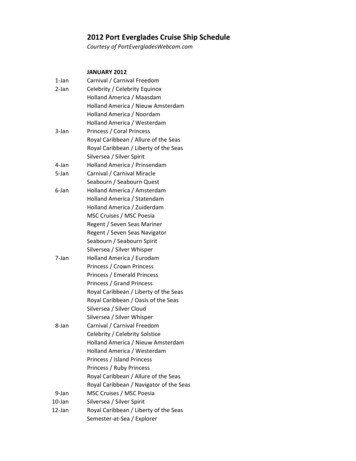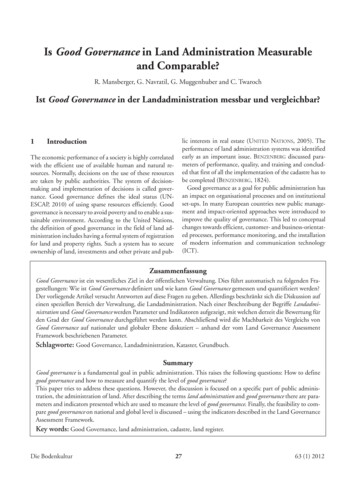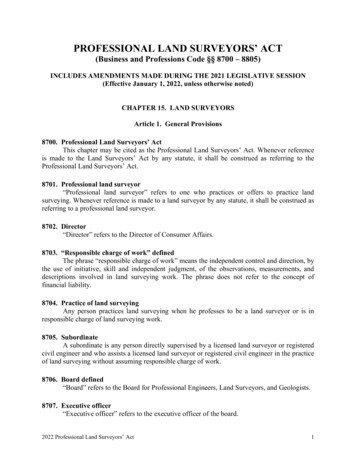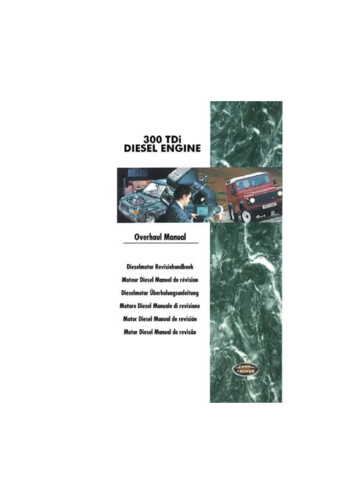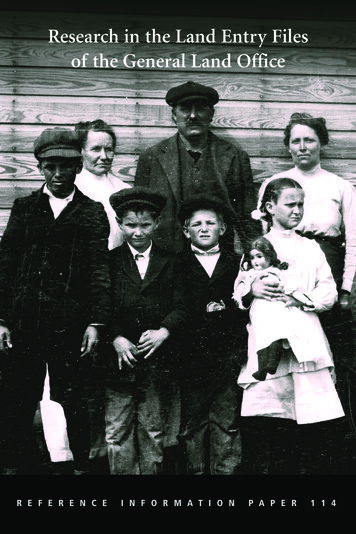
Transcription
*****THE HOLLAND LAND COMPANY IN WESTERN NEW YORKBy Robert SilsbyTHE hopeful settler who traveled into the wilderness of Western New York during the early 1800's faced many problemsand dangers which would have discouraged lesser men. Likemost of the pioneers who chose to attack and subdue the unsettled West, he was full of courage and looking for a new way of life.Packing his most necessaryhousehold and farm goods and supplies intohis covered wagon or even onto the back of his single ox, he headedwestward. Behind him came his sons -drivinga cow, a few sheep,and hogs. Often his wife and daughters trudged along on foot with afew precious treasures in packs on their backs.Which route westward did the family take? Was it the Great WesternTurnpike, which ran over the hills from Albany to Ithaca and Bath?Was it the Hudson-Mohawk and Seneca Turnpikes to Canandaigua,then on to Buffalo? They might even follow one of the ancient Indiantrails. Whichever route the family had to take, it was through a forested wilderness they passed.Many farms were still covered with a massof fallen trunks, branches of trees, piles of split logs and of squaredtimbers, planks and shingles. ". .often in the midst of all this. could bedetected a half-smothered log-hut without windows or furniture, but wellstocked with people." Where fields were being cultivated, the tops oftree stumps stood surrounded by the young grain.These were common sights as the pioneer family slowly made its waywestward through the GeneseeCountry. They crossedthe GeneseeRiverat Avon then pushed through the wilderness to the frontier village ofBatavia. Here the heavy wagon turned into the yard of Rowe's tavern,just acrossfrom the most imposing building in the village, the office of theHolland Land Company.During a visit to the land office, the family learned which areas werebest for settlement and what the terms of purchase were to be. Oncelocated on the land, it would be necessaryto visit the land office again tocomolete the rleal and to sign the papers. During the early 1800's, hundreds of families purchased property from this company which ownedmost of the land west of the GeneseeRiver .The large holdings of the Holland Land Company in Western NewYork had a varied history of ownership. In early colonial days, the Kingsof England granted the rights to huge pieces of land in the new worldto friends and relatives. Because of grants to the Plymouth Companyand the MassachusettsBay Colony, the State of Massachusetts claimedt},is territory. However, because a similar grant had been made to theDuke of York, after whom the State was named, New York also claimed
j 'T'\ '\'";';PaulBusti-General Agentof theHollandLand Company.the western area. To complicate thesituation, the United States Government had recognized the rights ofthe Iroquois to this same land.In 1786, representatives of theState of Massachusetts and NewYork met in Hartford, Connecticut.Here, Massachusetts agreed to giveup its claim and the Iroquois territory was recognized as part of NewYork. However, it was decided thatif these lands were purchased fromthe Iroquois, Massachusetts wouldreceive payment for them. After theHartford Convention, a companyorganized by Phelps and Gorhamcontracted with Massachusetts forthe rights to the land in WesternNew York. When they were notable to keep up the payments to theState of Massachusetts, the right to purchase land was sold by Massachusetts to Robert Morris.In 1791, Robert Morris -financierof the American Revolution-bought 3,000,000 acres of land in Western New York. Morris, whohad large investments in Europe, was pressed by debts. So in 1793 hesold most of his holdings to a group of merchants in Holland.Although five banking houses in Holland were involved, their interests were so closely related that they picked a single agent to managetheir lands. This group became known as the Holland Land Companywith headquarters in Philadelphia.Before The Holland Land Company could begin to resell their land,the Indians title to it had to be transferred to them. A council was heldat Big Tree in the summer of 1797 attended by the Iroquois sachemsand their tribes; Morris; James Wadsworth, representing the FederalGovernment; and Joseph Ellicott on behalf of the Holland Land Company. The Seneca chief, Red Jacket, was difficult to deal with. Itwas necessaryto give presents to influential women of the tribe and tomake generous bribes to several chiefs in order to persuade the Indiansto grant their land rights to the Holland Land Company. About200,000 acres were set aside for reservations.The way was now clear for a survey of the great tract of wilderness.Indian reservations as well as the mile-strip belonging to the State ofNew York, had to marked out. The areas had to be divided into townships, six miles square. In all, fifteen ranges or tiers of townships were2
StoneMarkeronTransitLineNowin BuffaloandErieCountyHistoricalSociety.marked out. The townships were divided into lots of 320 acres each.Where necessary, these lots were subdivided into 120 acre tracts. Itwas a trying task, even for the most courageous person.Courage and devotion to duty were traits that marked Joseph Ellicott,the man who was selected to supervise this huge survey. Born into afamily of surveyors, Joseph was trained by his elder brother, Andrew.He had assisted his brother in surveying the city of Washington soonafter it had been picked as a site for the capital. In 1791, he was commissioned by the Secretary of War to run a boundary between Georgiaand the Creek Indians. He then aided in surveying a great tract of landin nortpwestern Pennsylvania. In 1789, as an employee of the U. S.Government, he had determined the boundary between Pennsylvaniaand New York and set the location of Erie as being in Pennsylvania.As well as being in charge of the survey, Joseph Ellicott was appointed agent in charge of land sales for the Holland Land Companyin Western New York. He held this post until 1821.Ellicott entered the woods in the spring of 1798 with about 150 mento begin the survey. With the aid of a movable transit that he and hisyounger brother had constructed, he began a very careful marking outof the boundaries. Often it was necessary to cut a path through thedense forests. Permanent stone markers were set in regular intervalsalong the boundaries of the Indian reservations and other large tracts.By the end of 1800 the main part of the survey was complete and theranges and townships were marked out.The year 1801 marked the be inning of land sales on the HollandPurchase. Ellicott's first land office was located in the tavern of AsaRansom at Clarence Hollow. However, he soon moved to Batavia where3
he set up a permanent office. During the next twenty-five years, as settlement spread to various parts of the Purchase, sub-agents were established in Chautauqua and Cattaraugus Counties and in the Villageof Buffalo. Among these men were two who are prominently related tothe growth of their areas, William Peacock in Mayville arid ErastusGranger in Buffalo. But Batavia remained the main office.The first recognized land deed in the Purchase was issued to WilliamJohnson in 1804. Johnson had been given a tract of land on BuffaloCreek by the Senecaswhen he was the British Indian agent. This tractwas included as Seneca land in the Holland Purchase and in return,Johnson was given deeds to lots in the newly-surveyed Village of Buffalo.Ellicott possesseda wide understanding of frontier problems. A bigman, well over six feet in height, he was industrious, careful, and orderlyin his businessdealings. He hoped to set up a reasonable plan for salesof land to the settlers. Realizing the poverty of many who chose to moveWest, he favored a system of credit that would give settlers ten or twelveyears to pay.The proprietors of the Holland Land Company, however, were farremoved from the problems of frontier life. They directed that salesshould be made on a four- or six-year contract. If a person chose thefour-year contract, he was to pay one-third of the price down; if hechose the six-year contract, he was to pay one-fourth down. No doubt,Ellicott smiled as he read the instructions. He must have known thatboth the credit terms and the downpayment required would be impossible for most of the new settlers to meet.Even before salesbegan, Ellicott received a letter from Paul Busti whowas the general agent for the company in Philadelphia. This letterinstructed Ellicott to lower the required down payment to 15 percent forlarge-scale buyers and to 10 percent for purchasers of small lots. Butexperience soon proved that even this decrease was not enough. Manysettlers arrived with little or no cash at all for the purchase of land. Onepioneer, Richard Cary, who settled on Eighteen Mile Creek, arrivedwith just three cents in his pocket. He was two dollars in debt.Pioneers who had money were concerned with the cost of settling andliving through the first year on the frontier. Even these often refusedto pay down the required amount. Within a few weeks after he hadbegun land sales,Ellicott knew that downpayments would have to be lessif the company hoped to sell large amounts of land.He sent a letter to Paul Busti, in Philadelphia, explaining the problemand sugf!;estinga change. Settlers were being attracted by the easy termsoffered by land agents in Canada and in other parts of Western NewYork. Land in Ontario was being sold for as low as 6 pence an acre whilein Niagara County, the starting price was about 2.75 an acre. Sincefew men with money were willing to leave the comforts of the East to4
Joseph Ellicott completing Survey in Buffalo, 1804. Depicted are Ellicott,William Johnson at the present Exchange Street looking east from Main Street.Crow's Tavern at the right.Diorama in Buffalo and Erie County HistoricalSociety.settle in a wilderness, most settlers were too poor to pay the required10 percent.Yet land was being sold. In some cases the local agent made a salewith the agreement that the buyer would meet his downpayment bydoing some labor for the company. Some settlers helped open roads.Others aided in the construction of sawmills and gristmills.Settlerssometimes paid by making shinglcs for the company buildings. Manywho seemed honest and industrious were allo\\,ed to make very smallpaymentsa few as small as twenty-five cents. There is record of oneearly settler on the Ridge Road in Hartland who had only four dollarsto pay down. After he had paid that sum, two dollars were returnedbecause he had to journey back to the East. Another man, who settledin Chautauqua County, left his \\'atch at the land office until he couldearn enough money to pay down.In many areas, Ellicott began a system of conditional sales. Thispermitted the newcomer to take a lot and begin improvements. Usuallyhe was given six months to make some improvement and raise thedownpayment.Then a land contract, which guaranteed the land tohim after he had paid for it, was issued. The time limit set by the agreement was not always strictly enforced.As with the demand for downpayment, the company's policy regarding the length of time required for payment proved unwise. A periodof four or even six years was usually not enou, h time for the pioneerto raise the cash to fully pay for his land. Although the settler could,after the first year, raise enough crops to provide for his family, hischance of selling any surplus for cash was very slim. Since he was farremoved from the markets of the eastern seaboard and transportationcosts were high, there was little or no profit in shipping farm produceoverland. Thus the pioneer farmer had to depend largely on the localmarket during the first few years of settlement. This was a poor market.5
"The Old Holland House" --Office of the Holland Land Company,erected1806,now Holland PurchaseMuseum,Batavia,New York.The situation began to improve after 1808 with the growth of tradeacross Lake Ontario to Montreal. Porter, Barton & Co. developed atransportation businessto -by-passthe Falls by the old Indian portagewhich easedthe problem of shippin.g goods out of the Buffalo-to-Lewiston area. But this was little help to the earliest settlers nor to those wholived in the southern part of the Purchase. The marketing difficultieswere not satisfactorily solved until the construction of the Erie Canal.These practical considerations and the fact that land was being soldon longer credit terms and at a cheaper rate in other areas causedEllicott to urge that credit be extended for a ten-year period. Bustiagreed to this in 1803. By the end of the decade, Ellicott felt that thingshad improved enough to again shorten the credit period to six years.Busti questioned the wisdom of such a change, but finally agreed to aneight-year term. This became the general policy of the company forthe remainder of its stay on the Purchase.Fortunately, the agents of the Holland Land Company were awareof the hardships that the settler faced in making a home in the wilderness. But they were also wise enough to know that those who could,must be made to pay.Legally, it was a simple matter for the Holland Land Company totake action against settlers who refused to keep up their payments.Most settlers were given land contracts by which the company agreedto deed the land when the buyers made the final payment. Title to the .land remained with the company until then. A debtor who did not makepayments could be put off his land without difficult legal action. However, such eviction was seldom used. From his Philadelphia office, PaulBusti instructed that the power to enforce payments should be used6
,\,ith the "utmost caution and discretion." He urged suing to collectdebts rather than moving a settler from his home.Like other creditors on the frontier, the agents of the Holland LandCompany tried taking produce in payment for debts. This helped thestruggling settler turn his surplus crops into cash. During the seasonof 1806, Ellicott announced that grain would be received as paymentfor interest. About 450 bushels were collected during the 1806 and 1807seasons. But the marketing problems soon forced Ellicott to give upthe plan. Without roads or a canal it was too expensive to transportgrain to Albany for sale.Ellicott then tried to sell the grain to the incoming settlers who wouldneed it for food and planting during the first season. But his hopes ofgetting cash this way also failed. Most of the newcomers were willin.l?;to buy only on credit. He tried to sell produce by personal notes butmany of the settlers drifted on to other frontiers leaving their debtsunpaid.In spite of the disappointing results of this first experience, the company again agreed to take cattle and wheat during the hard times thataccompanied the depression of 1819. Because many settlers preferredto sell their crops for cash, the company agreed to allow 15 percentabove the market price when produce was received in payment ofinterest. This policy was followed until the Dutch began to withdrawfrom the Purchase in 1835.In addition to supporting the new settlers by a generousinterest policy,the Holland Land Company contributed several worthwhile public improvements to Western New York. In order to open up land for settlement, Ellicott undertook an extensive road building program. Roads,connecting Batavia with the older settlements to the east of Avon andGeneseo, were begun during the first season. Others fanned out tothe west and north, linking Batavia with Buffalo, the Niagara River ,and Lake Ontario. Work on these roads proved a boon to many settlersfor the Holland agent paid 40 per mile, two-thirds payable in landand one-third in cash.Later the company made a generous donation in order to remove asandbar which blocked the mouth of the harbor at Portland on LakeErie. A sawmill and gristmill, so essential to the early settler, wereconstructed at the company's expense in Batavia. Generous loans wereoffered to encourage others to build similar mills at different placeson the Purchase. Gifts of land were made to the first two blacksmithsin the area. A loan of 3000 was made to aid in the establishmentof the first general store at Batavia. Also, to provide resting placesfor travelers going west, the company offered free land at ten-mileintervals, along the roads as they were opened up, to anyone who wouldbuild an inn.
Many who sought new homes in the wilderness brought with themdeep feelings for religion and education. In announcing the openingof sales, Ellicott had promised to donate land for both purposes. Assettlers moved in and formed congregations, the company gave them aplot of land for their church. Ellicott also contributed money to aidin the construction of the church buildings. The usual gift was 200or 300, but the company contributed 1800 toward the EpiscopalChurch in Batavia. It was equally generous in aiding the constructionof St. Paul's Church in Buffalo. To encourage the organization ofschools, tracts of not over one-half acre were granted to a school district, although appeals for aid to build schoolhouseswere turned down.The Company contributed 2000 to a committee formed to aid thosewho had suffered lossesduring the British raid and burning of Buffaloin 1813.Regardless of the help given to the settlers, the agents of the HollandLand Company frequently found themselves in trouble with those wholived on the Purchase. During the first ten years of settlement, difficulties arose becausethe company insisted on selling land on contract. Thecompany favored this arrangement because it made it easy to put atenant who failed to keep up his payments off his land. The settler ,however, did not like it for it meant that he could no have title to theland until he had completely paid for it. Ownership carried with it astanding in the community which many were unwilling to delay whilethey worked to pay for it.The company was forced, finally, to give in to the demand for deeds.The first step was taken in the summer of 1802, shortly after GeneseeCounty was organized. By state law, many of the new county officershad to be landowners. Ellicott estimated that there were not more thanthirty landowners in the entire county -noteven enough to formgrand juries. It was necessaryfor the company to grant deeds to anyone who would pay at least one-fourth of the purchase price of theland. Even this change was not enough to solve the problem. Withinfive years, there were not enough landowners in one township to fillthe juries.Even though the company had made substantial contributions topublic improvements, there were people who thought it should do more.The company was often criticized for its failure to provide adequateroads. An Englishman, traveling through the Purchase in the early1830's, described the sensation riding in a stagecoach over a corduroyroad. "By holding fast, one could keep one's seat tolerably well, withoutmu h fear of dislocation," he declared.Ellicott was satisfied with a minimum effort. He did little to improvethe original roads even though some were impassible during the springand fall. Along many of these roads the company owned most of the8
Ellicott Mansion-Batavia, New York, built 1822.lots. Accordingto the state law, the land of non-residentswas notsubject to road tax. No wonder that the residents complainedandrequested the legislatureto tax these lands.Anotherreason for local irritationwith the HollandLand Companydeveloped over the Buffalo harbor project.There was a sandbar acrossthe mouth of BuffaloCreek.When the Erie Canal was started, itseemed probable that unless it could be cleared from the harbor, thecanal would end at Black Rock.In 1818, a group of leading Buffalocitizens asked the state legislaturefor financialaid to improvetheharbor.The legislatureordered a survey.This commissionreportedthat a breakwatercould be built for about 12,000.The legislatureoffered a loan for the work, with the conditionthat it would be a giftonly if the Erie Canal ended in Buffalo.A group of citizens turned to the HollandLand Company,askingthat they give a partial guarantee against loss if the state should demandrepayment.The companyrefused on the grounds that the harborimprovementwas backed by a private group of citizens rather than bypublic authorities.The project went ahead withoutcompany supportand the state eventuallypaid for the work.But this incidentbecamea reason for bitter feelings toward the company.Althoughthere had been minor criticismsof the company since thebeginningof settlement,the first general attack came in the fall of1819. Late in September a series of articles, signed by AgricolaJ beganto appear in the Niagara Journal.The author charged that the company was asking too much for its lands. It said the company had notdone its share in contributingto communityprojects.Futhermore,thearticle chargedthat the HollandLand Companywas drainingthearea of cash by sending all of its collections out of the country to Hol-\9
land. .In .renewing contracts, the company was accused of increasingthe pnnclpal of debts. The author recommended that the legislaturebe asked to tax company lands so highways could be maintained andschools built.A meeting of residents of Niagara County was called to draw up sucha petition. They met in Cook's Inn on October 28, where a petitionwas written asking the legislature to tax lands of non-residents for themaintaining of roads and building of schools. This petition was sentaround the Purchase, and some 1300 settlers signed it. In Albany, thepetition was given to a committee of the assembly headed by OliverForward, who had presided over the meeting at Cook's Inn. A lawto tax the company lands was introduced in the assembly and passed,but it was not taken up in the New York State Senate.What was behind these criticisms of the company? No doubt, theserious economic distress which went along with the depression of1819 was partly responsible for the complaints. With wheat sellingfor as little as twenty-five cents a bushel, it was difficult for settlers tomake interest payments on their land contracts. Furthermore therewere those who disliked Joseph Ellicott and tried to hurt him byattacking the company.Among the leaders at the meeting at Cook's Inn were AugustusPorter and Benjamin Barton, who early in the settling period had atransportation monopoly around Niagara Falls. In 1811, Ellicott hadbeen successfulin preventing a renewal of this monopoly being granted.His influence in Albany and position as virtual political boss on thePurchase turned others against him. The critics picked a populargrievance to emphasize. It irritated practically every settler on thePurchase that the company owned large areas of land which were taxfree, while roads and schools needed improvement.The land tax bill had received little support in the senate. This,however, did not mean an end to Ellicott's troubles. His enemies beganto attack him directly and urged that he be replaced by Samuel M.Hopkins, a man who had developed land on the GeneseeRiver. SamuelWilkeson, a leader in the plan to develop Buffalo harbor, circulateda petition that denounced Ellicott as one who was hated by the settlersand who interfered in politics. Busti, the general agent, receivedletters from leading officials and from the Governor of New York State,praising Mr. Hopkins.There were also personal differences existing between Ellicott andBusti. More than once, Ellicott had failed to carry out instructionssent from Philadelphia. Thus, with the defeat of the land tax bill,Ellicott was asked to resign. Not wishing to become involved in localpolitical quarrels, Busti did not side with local suggestionsfor his successor. He picked Jacob S. Otto, a Philadelphia businessman. The10
change in agents and the revival of the system of taking produce inpayment of interest, brought a calm to the Purchase for the nextseveral years.During this period, Otto decided to tighten the system of collectingdebts. He was sure that Ellicott had been too easy on the settlers andthat most debtors could pay something. While there may have beentruth in Otto's belief, his policy of bringing suits against many of thedebtors was hardly the way to improve the situation.Reaction came quickly under the leadership of Benjamin Bartonand Peter B. Porter, Ellicott's old enemies. Protest meetings were heldin Lockport in January 1827 and in Buffalo early in February. Again,petitions were adopted urging the company to lower the price of land,to reduce the debts of those who were willing to pay a portion. Againa demand was made for a highway tax on company lands. The meetings ended after forming an association called The Agrarian Convention of the Holland Purchase.The petitions were sent to Albany where a bill to tax land of nonresidents quickly passedin the assembly. It was defeated in the senate,due to the influence of the absentee landowners. The victory was shortlived. The measure was brought up again in the autumn and passedboth housesof the legislature before its opponents could move against it.Paul Busti had been in Albany during the debates on the tax bill. Hehad learned much about the thoughts of the settlers from persons fromthe western part of the state. The collection reports he had receivedfor 1826 were hardly encouraging. Out of a total debt of six million-dollars, the company had collected only about one-fiftieth. conversations in Albany convinced him that collections would pick up only ifthe burden of debt were lightened.A plan was worked out with David E. Evans, who had replaced thedeceased Jacob Otto. All settlers were given one year to renew oldcontracts. The principal was reduced on these contracts if the tenantpaid one-eighth of the new price. The company agreed to set asidemore money for improving and opening roads, the work to be done bythe settlers and payment applied to their debts.The new plan was greeted with joy by the settlers. Crowds gatheredat the land offices to have their contracts changed. Within a year,nearly 300,000 had been collected. Many farmers were planting morewheat so that they could keep up their payments.But what of those who failed to take advantage of the new plan?William Peacock, subagent in Chautauqua County, reported that therewere settlers who refused the new offer in the belief that the HollandCompany would not dare to try to take their land. No doubt Evansshould have singled out a few people and begun eviction proceedingssoon after the one-year time limit had passed. Instead, he issued notices,
William Peacockof Mayville, New York.each of which lengthenedthe time limit.In the meantime,enemies of the HollandLand Companywere stillat work. On February 4, 1830, the village of Buffalo was strewn withhandbillsannouncinga public meeting to question the company'stitleto their lands in Western New York.This line of attack proved unsuccessful. A second meeting held early in March aroused a more seriousthreat to the company.IRstead of stressing the question of the company's land title, resolutions were passed urging the legislatureto taxthe debts due to non-residentsfor lands in the state. Tl.is would haveput pressure not only on the HollandLand Companybut on the Pulteney Estate to the east.For the moment the landlords were able to delay action in the legislature.During the 1833 session, however, a law was passed to tax thedebts due to foreign landowners.Both the Hollandand Pulteney interests had worked against it, but they had been defeated.The new law made it necessary for the companyto reduce theamount of debts owed them as soon as possible. Collections would haveto be stepped up. In the fall of 1833, Evans sent out notices warningthat unless back interest were paid by January1, the contracts wouldend and the land would be taken back by the company.By the endof the year, more than 3,000 settlers had paid up their back interest;Evans had sent over 250,000 to Philadelphia.In addition,new contracts and mortgages required that the settler pay the tax on the debt.A wave of objectionquicklyspread throughthe Purchase.Publicmeetings were held to protest the new companypolicy.Resolutionswere framed by various groups.One gatheringdeclared,"Thatwecherish the spirit which actuatedour fathers in the achievementofour Independence,and we like them will revolt from the payment oftaxes which ought to be paid by a HollandCorporation,."From Jamestowncame a call for a general meeting to be held at1?
Buffalo. Delegates from allover the Purchase hurried to Buffalo byhorseback and sleigh on February 19, 1834. The company was loudlycondemned for giving up its earlier lenient policy. A resolution waspassedto make no further payments until they changed the new policy.It was further agreed that those assembled would come to the assistance of any settler who might be put off his land by the company. Themeeting concluded with an attack by Thomas Sherwood on the company's title to the land.Sherwood's speech served to increase opposition by the settlers invarious parts of the Purchase. At least one newspaper urged the settlersto make no further payments, saying that the Dutch never had titleto the land. The company met opposition with force. Agents singledout the most noisy and better-known debtors and began eviction suits.By agreement with the leaders of the Agrarian Convention, five of thesewere selected to test the company title. These suits were tried in theUnited States District Court in Albany in 1835. The result was a complete victory for the company. With its title now secured by legaljudgement, the Holland Land Company vigorously pushed suits to putdebtors off their land. This was necessary to impress the public thatthe company meant business and also to discredit the leaders of theAgrarian Convention. Most of the other suits were settled without trial.In the meantime, the Holland Land Company agents had been busylooking for purchasers f
The first recognized land deed in the Purchase was issued to William Johnson in 1804. J ohnson had been given a tract of land on Buffalo Creek by the Senecas when he was the British Indian agent. This tract was included as Seneca land in the Holland Purchase and in return,


